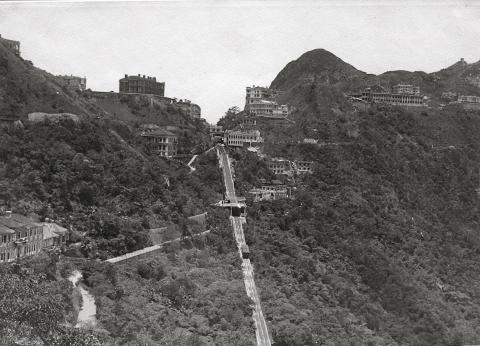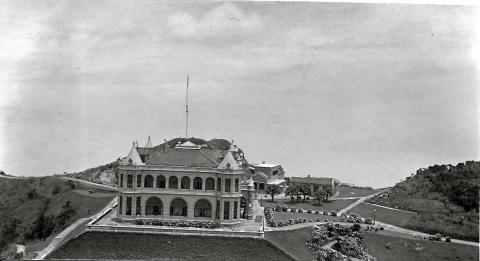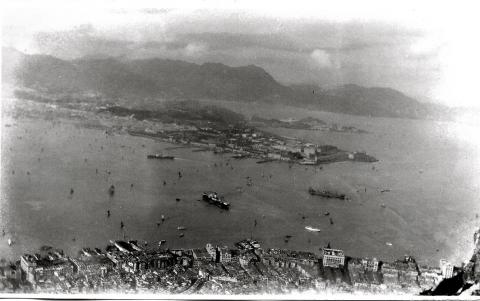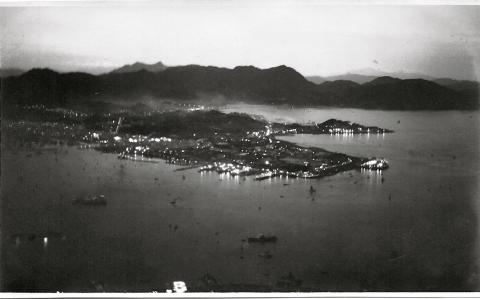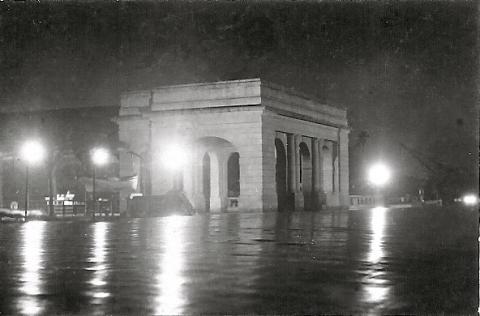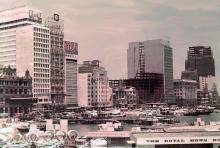A Long Commute, Morrison Hill Disappears, Seeing People Off, and Horses in Kai Tak
Primary tabs
In the summer of 1932 we left Braemar Terrace and went to live
in Kowloon. As we were going Home on leave in 1933, we did
not take a flat but stayed at the Knutsford Hotel. It was a long
journey for me in the mornings and evenings because H.E. and
Lady Peel were in summer residence at Mountain Lodge. From the
Knutsford Hotel, I travelled by bus to the Star Ferry, then by
ferry across the harbour, by rickshaw to Battery Path, by chair to
the Peak tram, tram up the Peak, and Governor's chair to Mountain
Lodge. However, I was quite happy!
Rickshaws, the Peak Tram and the Mountain Lodge.
Crossing the Harbour in the ferry took ten minutes. We sat out onthe open deck, where there were rows of seats with adjustable
backs, so that they always faced in the direction we were going.
Who could fail to enjoy this pleasant way of travelling across the
bustling, ever interesting harbour? In the evenings, going home,
often there were gorgeous sunsets that lit up sky and sea.
Kowloon by day and night
The waterfront on the Hong Kong side was called the Praya -
from the Portuguese. There was a series of Piers. . On one
side of the Star Ferry Wharf was Queen's Pier, the official landing
place at Statue Square; and on the other side was Blake Pier, where one hired a motor boat at night if one had missed the last ferry after a dance. These motor boats were called "Walla-wallas"
for some unknown reason. Beyond were the wharves of the
Canton and Macao steamers and various ferries going to places
in the New Territories or to Lantau and other islands.
Queen's Pier
It was all reclaimed land, as indeed was Causeway Bay and all
the waterfront land in both directions. The Chinese were wonderful
road builders and hill demolishers. In our time Morrison Hill was
flattened for new development, a great feat. Men and women worked
together, dozens of them at a time. The women squatted on the
ground breaking huge stones into little ones with hammers, wearing
metal guards on their fingers. The famous Hong Kong roads were the
result of these amazing people's joint work. I think that most of these
builders were Hakka people, the women who wore the big hats
with curtains.
View of Causeway Bay
On the Kowloon side near the Star Ferry Wharf was the Railway
Station, terminus of the Kowloon Canton Railway, and the Signal
Station on the top of which was the time ball and where weather
signals were displayed. The signals warned when a typhoon was near, and the time ball dropped with a bang every midday! Nearby
was the Peninsula Hotel, Hong Kong's newest and tallest, seven
storeys high.
From this part of Kowloon one had the most famous of the Colony's
views, "Hong Kong by Night", celebrated in paintings and photographs.
It really was a scene from fairyland, especially on a starry night -
lights in the harbour, lights in Hong Kong all the way up the Peak,
and stars in the sky. You couldn't tell where the lights ended and the stars began!
On the other side of the Star Ferry were the wharves where the
big steamers berthed, those that sailed to Europe, the P. and 0.
liners "Carthage", "Corfu", "Canton", "Cathay" and others (Peninsula
and Oriental Steam Navigation Company); and the Blue Funnel
liners "Patroclus", "Antenor", and others (Alfred Holt and Company);
the French ships "Athos", "Porthos", and "D'Artagnan" of the
Messageries Maritimes Line. And the ships that crossed the Pacific,
"Empress of Canada", "Empress of Asia", "Empress of Japan" of the Canadian Pacific Line; "President Hoover", "President
Coolidge" of the U.S. President Line; "Asama Maru", "Tatsuta Maru",
"Chichibu Maru" of the NYK (Nippon Yusen Kaisha).
Dates of arrival and departure of all ships were advertised in the
local newspapers. The P. and 0. line carried the mail between
Hong Kong and Europe. Each week one mail ship arrived and
another departed. Expected dates of Home mails were advertised in
the papers and in the Post Office. The sea voyage took five weeks.
If we wished to send our letters by a quicker way, we marked them
"Via Siberia". Then they were taken up to Vladivostok by coastal
steamer, and on to Europe by the Trans-Siberian Railway, a
transit of three weeks.
At this time a riding-school was started at Kai Tak in Kowloon by
Captain Daniloff, a White Russian ex-Cossack Officer. I joined the
classes, with Audrey, Eve, Margaret, Rosemary, Eileen Bonnar,
Edna and Kathleen. We Hong Kong girls were not much good
at riding the frisky China ponies, because most of us got thrown.
Captain Daniloff must have been most disappointed in us! I was the
first to give up this alarming exercise, and soon for us the riding lessons ended!
In spite of working in our offices from 9 a.m. until 5 p.m.
every day, and on Saturdays from 9 a.m. until 1 p.m., we led a tremendously active social life. My diary of this time records lunches, teas, dinners and dances.
In March 1933 Kathleen, with Bill Telfer and the Olivers, Molly
and Ken and Phyllis, went Home on leave, in the Blue Funnel
s.s. "Hector", and we went on board to see them off.
"Seeing off" was a great custom in Hong Kong. An hour before
sailing time, the ship's lounge would be full of people having
drinks. Soon we heard the sound of the ship's engines and
the cry "All visitors ashore", and we descended the gangway
to the dockside to wave goodbye to our friends leaning on
the ship's rails.
Usually "Home leave" came every four years, and the time spent
away from Hong Kong was nine months, which included the sea
journeys of five weeks each.
In April and May 1933 came our turn to go on leave! Mamma
and Audreyfirst, and I a month later. I stayed with Zoe and
Bill Williams until my departure. She was a White Russian, Ithink from Shanghai, a gentle girl and a great favourite of Mamma. Her name was Zoya Leek before she married Bill. They came on board
to see me-off when I sailed in the P. and 0. liner "Carthage".
And so Audrey and I saw England for the first time when I was
22, and she was 21; and Mamma met her relations again after
24 years.

